Pantheon Art Story | Location | Opening Hours Tickets | Authorisations
Art Story Story | Porch Rotunda | Cupola | Basilica | Chapels Tombs
The Porch and the Rotunda of the Pantheon in Rome Italy
The Dimensions and Architecture of the Pantheon
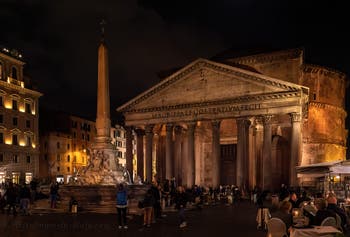
Outside of the Pantheon The Pantheon consists of three parts: the porch, the rotunda, and, in between, an enormous cement block uniting the rectangular porch to the circular wall of the rotunda.
Initially, a large forecourt over 100 meters long and bordered by fifty columns was in front of the porch.
You had to enter this forecourt and cross its entire length to access the entrance to the Pantheon, which must have added to the impression of grandeur when going to the temple.
All that remains of this forecourt is the space represented by the square in front of the Pantheon, but unfortunately, the walls and columns surrounding it have disappeared.
The Porch of the Pantheon
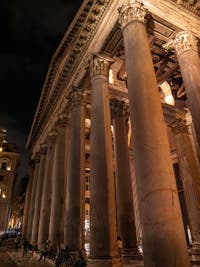
Porch of the Pantheon The impressive porch of the Pantheon is 34 m wide and 15.5 m deep.
In this porch stand majestically 16 monolithic grey and red granite Corinthian columns, 12.5 meters high and 1 meter 50 in diameter.
Their bases and capitals are in white marble.
You already feel tiny before you even enter the rotunda.
The granite columns on the Pantheon’s porch come from quarries in the mountains of eastern Egypt.
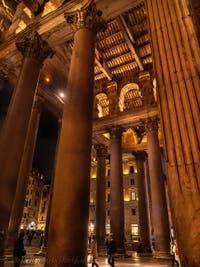
Porch of the Pantheon These columns were cut on-site to make them less heavy for transport.
They were laid down, carried on wooden carts to the Nile, then moved across the river using barges to Alexandria and loaded onto ships bound for Rome.
After crossing the Mediterranean to Italy, the Pantheon's columns were unloaded from ships and placed on barges to sail up the Tiber to Rome.
This shows that constructing the Pantheon's porch alone was a large-scale undertaking.
The Rotunda and the Cupola of the Pantheon
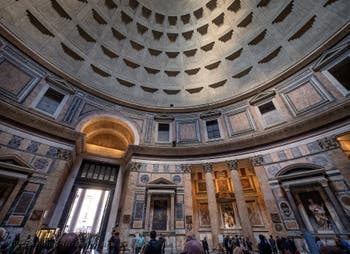
Cupola of the Pantheon The Pantheon is a circular temple: the interior of its rotunda measures 43.3 meters in diameter and 43.3 meters high up to the 9-meter diameter oculus that opens at the top of its dome.
These measurements are explained by the fact that the temple was designed and built as a ball 43.3 meters in diameter, a virtual sphere intended to fill the rotunda: the sphere of Roman Paradise.
Indeed, a perfect sphere is included inside the rotunda, represented by the circumference of a large circle extending from the ground to the top of the cupola.
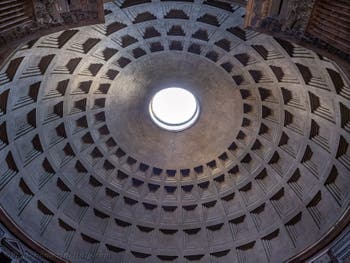
Cupola of the Pantheon The audacity of this design is one of the critical elements in the success of the Pantheon and the admiration it arouses when one enters this spherical space that conveys an impression of balance and grandeur, harmony and beauty.
A great moment of emotion touching eternity!
The dome of the Pantheon rests entirely on the circular wall of the rotunda.
A circular wall 6 meters thick and a cupola designed so that no beams or columns were needed to support it was an incredibly daring design for the time!
Built on swampy ground and close to the Tiber and its floods
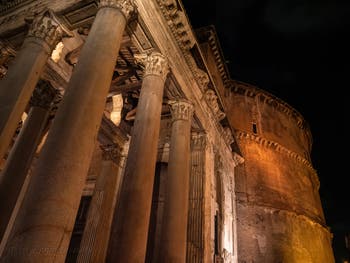
Porch of the Pantheon The main problem encountered during the construction of the Pantheon was its proximity to the Tiber and the risk of flooding from the latter.
To limit the risks associated with the Tiber floods, the architects decided to raise the Pantheon sufficiently so that it could remain above water during floods so that initially, it was necessary to climb five high steps to access the entrance porch.
In addition to the problem posed by the floods was added the fact that the location chosen to build the temple was quite swampy; it was, therefore, necessary to build solid foundations since the dome of the Pantheon weighs nearly 4,500 tons, plus another 4,500 tons for the circular wall of the rotunda.
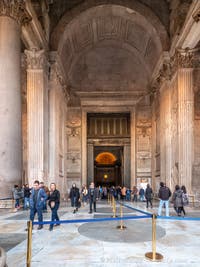
Porch of the Pantheon How to build foundations capable of supporting 9,000 tons in swampy terrain?
To do this, the architects dug a large circular trench about five meters deep and then filled it with cement.
The Pantheon rotunda: a circular wall six meters thick and 43 meters high
After these foundations were completed, work began to build the circular rotunda wall, a wall 6 meters thick.
To build this imposing wall, an enormous brick formwork was built to pour cement into it: at a distance of 6 meters from the first circular internal brick wall with a diameter of 43.3 meters, a second circular brick wall corresponding to the second partition of the formwork was erected.
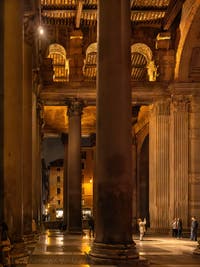
Porch of the Pantheon This circular brick formwork was then raised in successive sections 60 centimetres high.
As soon as a section was completed and dry, a layer of cement was poured to fill the space 6 meters wide and 60 centimetres high between the two walls of the formwork.
It is estimated that completing an entire 60-centimetre-high section took about a day.
And the following day, a new section of brick was made to pour in the cement and so on, until the rotunda wall was 43.3 meters high.
These brick walls composing the inner and outer walls of the formwork remained in place and thus became an integral part of the final thick circular wall of the rotunda.
The Rotunda: a solid, light and complex circular wall
The rotunda wall is more than just a uniform circular wall.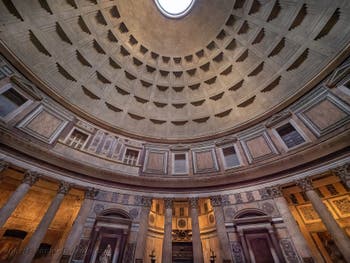
Cupola of the Pantheon Indeed, the architects created numerous “voids” in this wall, niches intended to accommodate statues, the Aediculae, and eight large bays that were transformed into chapels when the Pantheon was consecrated as a Christian church in the year 609.
The largest of the bays corresponds to the monumental entrance door to the temple.
And in front of each of the seven other bays, which have become chapels, stand two sizeable Corinthian marble columns sculpted in antique yellow marble, porphyry, or granite.
The aesthetic choice in creating these voids was also technical: it made it possible to lighten the structure of the rotunda wall while maintaining its solidity through the shapes chosen for this purpose.
The circular wall of the rotunda was completed in the year 120 when the architects initiated the construction of the cupola.
Next Page: The Cupola and the Oculus
Art Story Story | Porch Rotunda | Cupola | Basilica | Chapels Tombs
Pantheon Art Story | Location | Opening Hours Tickets | Authorisations
Back to Top of Page

